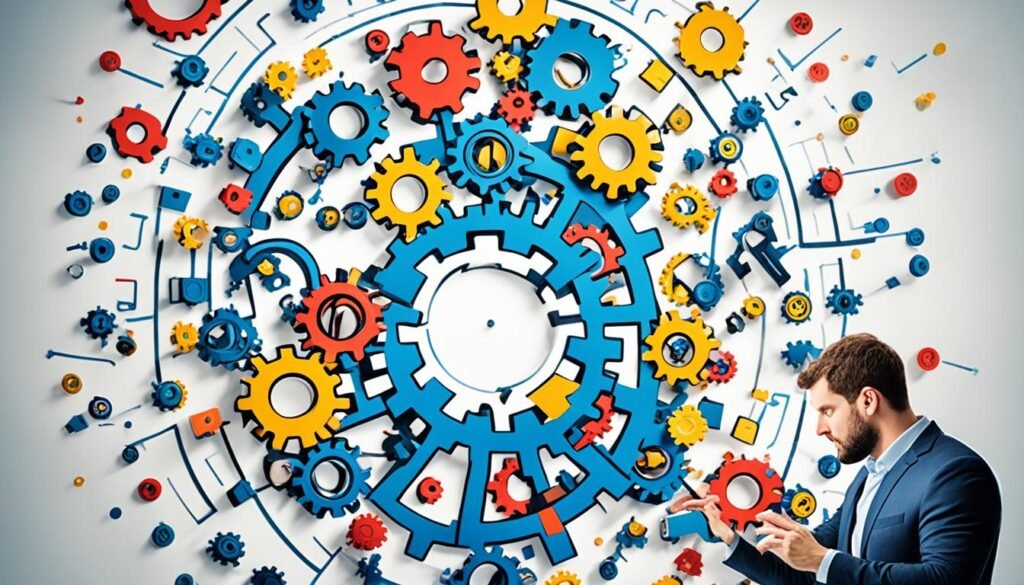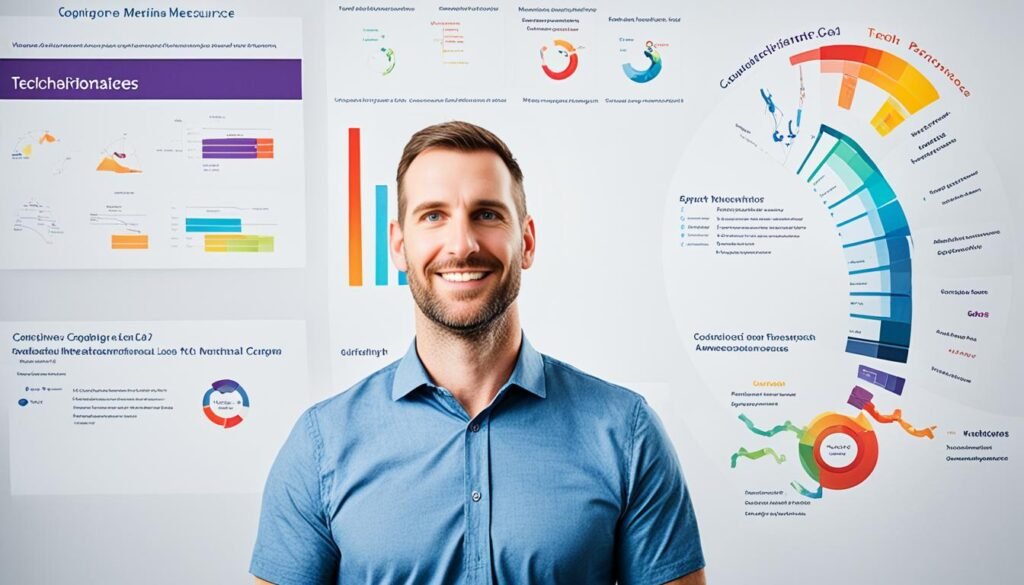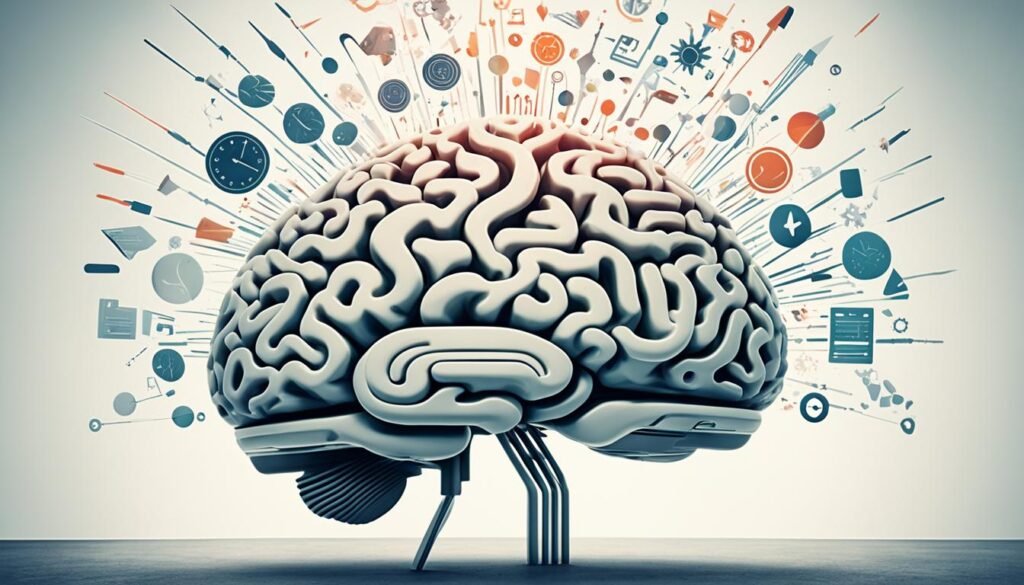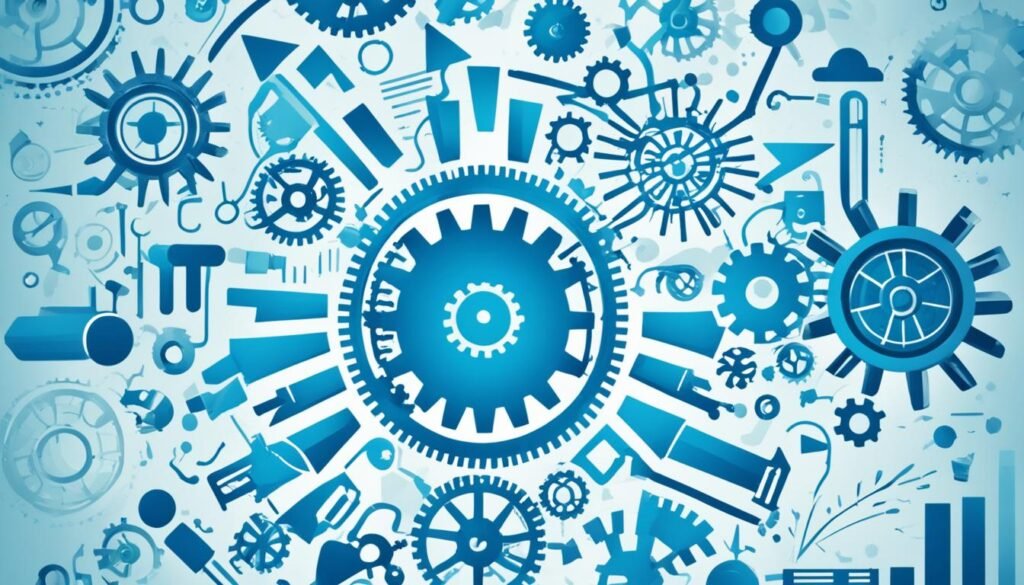Did you know humans can only hold about 7 things in their heads at a time1? This fact is key to Cognitive Load Theory (CLT), a new idea changing how we learn and process information. CLT was created by Australian psychologist John Sweller in the late 1980s. It looks at how our minds work and affects our performance23.
I’ve explored the world of cognitive load theory deeply. It shows how it changes learning, solving problems, and improving performance. CLT talks about three kinds of cognitive load: intrinsic, extraneous, and germane. Each kind affects how we keep and process information2.
Learning about CLT is like finding a secret to better mental work. It shows how our working memory, with its limits, can get too full. This can stop us from learning and doing our best3. By understanding this, we can make learning better, work smarter, and be more productive every day.
This look into Cognitive Load Theory will show you its main ideas, how to use it, and the latest research. We’ll find ways to lessen cognitive overload, improve how we process information, and reach our best mental performance. If you’re a teacher, a professional, or just want to use your mind better, this journey into CLT will give you useful tips for managing your mental load.
Key Takeaways
- Cognitive Load Theory explains how we process and retain information
- There are three types of cognitive load: intrinsic, extraneous, and germane
- Working memory has limited capacity, affecting learning and performance
- Reducing cognitive load can enhance mental efficiency and productivity
- CLT has significant implications for instructional design and personal development
Introduction to Cognitive Load Theory
Cognitive Load Theory started in the late 1980s by John Sweller45. It looks at how our brain handles information and affects learning and performance.
Definition and Core Concepts
This theory focuses on the limits of our working memory. Our brain can only handle three to four items at once, so managing too much information is key45. It splits our memory into working and long-term memory4.
Working memory can hold about five to nine new pieces of info for 20 seconds5. Long-term memory, however, can store a lot more. This difference helps us understand how we learn and process information.
Types of Cognitive Load
The theory talks about three kinds of cognitive load: intrinsic, extraneous, and germane4. Intrinsic load is the task’s natural difficulty. Extraneous load comes from how the info is given. Germane load aids in processing and building knowledge structures.
Importance in Learning and Performance
This theory is crucial for learning and designing lessons. It says to break down complex info into smaller bits to avoid too much overload4. By matching instruction to students’ levels and avoiding distractions, we can make learning better4.
“To improve learning, we must optimize extraneous load, manage intrinsic load, and promote germane load.”
Knowing and using Cognitive Load Theory can greatly improve how we learn and process information. This leads to better teaching methods and higher performance.
The Cognitive Architecture: Working Memory and Long-Term Memory

The human brain has a complex system for processing information. It starts with sensory memory, then moves to working memory, and finally stores information in long-term memory for later use6.
Sensory memory holds data from our senses for a brief time. For instance, visual information stays in this stage for about 500 milliseconds6. Then, working memory takes over, managing new info for 3-4 seconds and handling up to 7 chunks at once6.
Long-term memory is like our knowledge vault. It holds two main types of information:
- Declarative knowledge (facts, like math theorems)
- Procedural knowledge (processes for tasks)6
Cognitive Load Theory (CLT), introduced by John Sweller in 1988, looks at how these memory systems affect learning7. CLT says that how much information our working memory can handle affects how we process it7.
“All teachers should learn about Cognitive Load Theory to improve how they process, organize, and store information.”
To make learning better, teachers can use strategies like activating what students already know and making them recall information. These methods have been shown to greatly improve student performance7. Knowing how schemas form in long-term memory helps create better learning experiences.
| Memory Type | Duration | Capacity |
|---|---|---|
| Sensory | 500 milliseconds (visual) | Varies by sense |
| Working | 3-4 seconds | 7±2 chunks |
| Long-term | Indefinite | Unlimited |
Using both hearing and seeing helps reduce the load on our brains and improves learning7. This matches how our brains naturally process and store information.
Three Types of Cognitive Load
When we learn, our brains process information in different ways. Cognitive load theory, first outlined by John Sweller in 1988, explains how our minds handle new knowledge8. This theory says there are three main types of cognitive load that affect how we learn910.
Intrinsic Cognitive Load
Intrinsic cognitive load is about how hard the subject matter is. It depends on the topic’s complexity and what we already know910. How interactive the elements are also matters, as it affects how much information we need to process at once.
Extraneous Cognitive Load
Extraneous cognitive load comes from how information is presented. It includes things like explanations, diagrams, and study aids9. This type of load can differ from person to person and is often changed by how we teach10. Cutting down on extraneous load is important for good learning design10.
Germane Cognitive Load
Germane cognitive load is the effort needed to make information stick in our long-term memory. It involves building mental frameworks and automating processes10. This kind of load is good because it helps us learn new skills8.
| Cognitive Load Type | Description | Impact on Learning |
|---|---|---|
| Intrinsic | Inherent difficulty of subject | Varies based on topic complexity |
| Extraneous | Presentation of information | Can be reduced through design |
| Germane | Effort for long-term memory | Supports skill acquisition |
Knowing about these cognitive load types is key to making learning effective. By handling intrinsic load, reducing extraneous load, and boosting germane load, we can improve how well we remember and use what we learn.
“Proper management of cognitive load can prevent learners from becoming overloaded, which might impact their ability to process new information effectively or make appropriate decisions.”
Understanding Working Memory Limitations

Working memory is key to our thinking, acting as a short-term storage for what we’re using right now. Knowing its limits helps us use our brains better and keep information longer11.
Studies reveal that our working memory can hold about seven new items at once. This capacity can differ among people and grows as we get older11. In school, some kids might process information like someone three years younger or older, showing why teaching should be tailored11.
Cognitive load theory stresses the importance of managing working memory to improve learning. Too much information can slow down or stop learning11. To fix this, teachers and designers should use strategies to boost working memory12.
One good way is to give clear instructions with examples, followed by practice and feedback. This helps students learn better11. Also, breaking down hard topics and using examples can make learning easier, especially for beginners12.
Knowing about these limits is key for making good training programs and avoiding too much mental strain. By using strategies that consider working memory, we can improve learning and make better use of our brains.
Cognitive Load Theory in Educational Settings
Cognitive Load Theory (CLT) changes how we think about learning. It was first studied by Sweller in the late 1980s. Now, it’s key in designing lessons13.
Implications for Instructional Design
CLT talks about three kinds of cognitive load: intrinsic, extraneous, and germane. Knowing these helps teachers make better lessons1413. Dylan Wiliam said CLT is the most important thing teachers should know. He showed how crucial it is in schools13.
Strategies for Reducing Cognitive Load
To make learning better, teachers can:
- Avoid split-attention effects by combining related info
- Use worked examples for tough problems
- Give breaks for practice between different problems
These methods work well with how our brains learn, backed by strong evidence from CLT14.
Enhancing Knowledge Retention and Transfer
CLT supports teaching methods that help use working memory well. If the cognitive load is too high, learning suffers13. Signs of too much load include not remembering things and giving up on tasks.
| Cognitive Load Type | Description | Strategy to Manage |
|---|---|---|
| Intrinsic | Inherent difficulty of subject matter | Break complex tasks into smaller parts |
| Extraneous | Unnecessary mental effort | Streamline information presentation |
| Germane | Effort for schema construction | Promote active learning techniques |
Using CLT ideas, teachers can boost how well students remember and apply what they learn. This leads to better learning results.
Applying Cognitive Load Theory in Corporate Training

In corporate IT training, managing cognitive load is key for effective programs. Studies reveal that too much information is the top cause of poor training15. We must grasp how cognitive load affects learning and performance at work.
John Sweller, a psychologist from the 1980s, developed cognitive load theory. It helps prevent too much information from overloading the brain16. This is vital in technical training, where topics can be complex.
Old training methods often don’t work well. Long presentations or videos usually leave learners remembering only 7 to 11 minutes of the content due to too much information16. This is because people can only hold about seven items in their memory15.
To make training better, we should focus on three kinds of cognitive load:
- Intrinsic load: The natural difficulty of the material
- Extraneous load: Distractions in learning materials
- Germane load: The effort to make new connections
By thinking about these, companies can make their training better. For example, microlearning gives info in short, easy-to-follow chunks to lessen mental strain and help remember it better16. Research shows that training over 30 minutes can cause too much mental overload15.
Blended learning, mixing online modules with in-person classes, can also lessen cognitive load and improve learning16. This method offers flexibility and better control over the flow of information, leading to better performance and less employee turnover15.
By using cognitive load theory, we can make learning environments where employees learn and apply new skills well. This leads to better performance and higher job satisfaction.
Cognitive Load and Multimedia Learning
Multimedia design is key to how we absorb information. It’s all about finding the right balance to make learning more efficient. Cognitive Load Theory tells us our brains handle pictures and words differently, each with its own limits17.
The Split-Attention Effect
When making multimedia, think about the split-attention effect. This happens when learners deal with too much information at once, making it harder. To fix this, I suggest keeping text and images together. This makes learning easier and cuts down on mental work.
The Modality Effect
The modality effect says using both sight and sound can boost memory. This means we can learn better when we use both visuals and narration. For example, combining stories with pictures works better than just using one or the other17.
The Redundancy Effect
Don’t forget about the redundancy effect in multimedia design. It’s when too much extra info gets in the way of learning. To make learning stick, I aim to keep only the key info and leave out the extra18.
Knowing these effects helps us make better multimedia learning tools. By using these tips, we can make content that’s easy on the brain and helps learners more19.
Managing Cognitive Load in Complex Problem-Solving

Complex problems challenge our mental abilities. As a cognitive scientist, I’ve seen that smart strategies can make solving problems easier and use our brains better. Let’s look at how to handle the mental load in tough situations.
Breaking down big problems into smaller parts is a good move. This method helps learners learn how to solve problems without getting too stressed20.
Using worked examples is also a great way to learn. These examples show how to solve problems step by step. This lets learners focus on learning, not getting lost in new ideas. Starting with simpler problems and gradually moving to harder ones also helps manage the mental load.
“Simplifying and sequencing learning materials can reduce extraneous cognitive load, while active learning strategies can help increase germane load.”
In software development, there are ways to lessen the mental load:
- Code refactoring and simplification
- Improving documentation and code readability
- Automation of repetitive tasks
- Adopting pair programming
- Continuous learning
These methods boost productivity and make code better. They also help with learning and adapting20.
Cognitive load theory, introduced in the 1980s by John, shows how to manage different types of mental load. This helps balance our mental resources and keeps information in our minds better. Students who learn to manage their mental load do better on tests and remember more21.
| Cognitive Load Type | Description | Management Strategy |
|---|---|---|
| Intrinsic | Inherent to the task itself | Simplify complex tasks |
| Extraneous | Influenced by presentation methods | Improve instructional design |
| Germane | Supports schema creation | Encourage active learning |
By using these strategies and managing our mental load well, we can get better at solving complex problems. This also helps us use our brains more efficiently.
Cognitive Load Theory and Expertise Development
Cognitive Load Theory (CLT) explains how we learn new skills and become experts. It was created in the late 1980s by John Sweller and his team. They looked at how our brains work and divided knowledge into two types: primary and secondary5.
Novice vs. Expert Learners
Going from a beginner to an expert changes how we learn. Beginners find it hard with complex information because their brains can only hold a few new things at once5. This makes it tough for them to take in new info.
Experts, however, have built up their knowledge over time. They have special mental frameworks that let them handle complex info better. This helps them learn and perform better.
The Expertise Reversal Effect
CLT also talks about the expertise reversal effect. This means that what helps beginners might not help experts at all. For example, detailed instructions can help beginners but slow down experts who already know how to solve problems.
This effect is important for making learning better for everyone. It shows we need to change how we teach as people get better at a skill. This helps with learning and staying good at what we do22.
Knowing how beginners and experts think helps teachers and trainers make better learning plans. This way, they can help people grow their skills and become experts.
Measuring and Assessing Cognitive Load

Cognitive load measurement is key in making learning better in many areas. Researchers use different ways to measure how hard tasks are and how much mental effort they need. This helps teachers and designers make better learning materials2324.
Many people use their own feelings to measure cognitive load. They rate how hard they think a task is on a scale from very low to very high. This way, we can tell how complex a lesson is and what kind of mental effort it requires25.
There are also ways to measure cognitive load without asking people how they feel. These include looking at how well someone does a task, using two tasks at once, and checking their heart rate and how wide their pupils get. These methods try to get past what people think and focus on the real challenge of a task24.
New technology has given us more ways to measure cognitive load. Now, we can see what parts of the brain are working during learning. This gives us new clues about how our brains handle learning tasks23.
| Measurement Type | Examples | Benefits |
|---|---|---|
| Subjective | Likert scales, Visual Analogue Scale | Easy to implement, differentiates load types |
| Objective | Heart-rate variability, EEG, pupil dilation | Minimizes individual perception bias |
| Neuroimaging | fMRI, PET scans | Visualizes brain activity during tasks |
Learning analytics is always getting better, using these different ways to measure. By mixing what people say with hard data, we get a full picture of cognitive load. This helps us understand how it affects learning.
Cognitive Load Theory in the Digital Age

The digital era has changed how we learn and use technology. This change affects cognitive load theory, especially in e-learning and technology-enhanced learning.
Impact of Technology on Cognitive Processing
Digital tech has changed our brains. Our brains can only handle so much information at once. This includes learning stuff like how complex it is, who teaches it, what media is used, and distractions26. This is a big deal in online learning, where we often feel overwhelmed.
Online learning can be tough because it’s hard to start with new things. Beginners need clear steps to learn new elements, which can make it harder26. This is especially true for those new to e-learning.
Designing Effective Digital Learning Environments
To make online learning work, we need to think about how much information is too much. The guidance fading effect shows us that we should slowly stop helping learners as they get better26. This is key in online classes where time is short.
Breaking up learning into smaller chunks can help avoid getting tired during long sessions26. Using the imagination can also help learners practice and get better, especially for those who are more experienced26.
Working together can also help share the load and keep everyone engaged, especially in online groups26. This matches recent studies on the challenges of online learning, like using interactive media and getting fully into the learning.
| Strategy | Benefit | Application in E-learning |
|---|---|---|
| Guidance Fading | Gradual skill development | Adaptive learning modules |
| Spacing Effect | Prevents cognitive fatigue | Timed breaks in online courses |
| Imagination Effect | Enhances skill practice | Virtual reality simulations |
| Collaborative Learning | Distributes cognitive load | Online group projects |
By using these ideas, we can make online learning better. It helps our brains work better and improves how well we learn in the digital age.
Cognitive Load Theory and Performance Optimization

Cognitive load theory helps us reach our best in many areas. It shows how our brains handle information to make us more efficient and better at managing our thoughts. Our working memory can only hold two to four things at a time, which is key27.
To get better at handling information, we need to cut down on distractions and make complex info simpler. This makes it easier to focus and reduces extra mental load28. Breaking down information into smaller, meaningful parts helps us use our working memory better and process new info more efficiently27.
Improving how we handle information means making tasks fit our skill level. As we get better, we can take on harder tasks to keep growing. This is really useful in learning settings, where teachers can make lessons that challenge but don’t overwhelm students.
Using techniques like spaced-out retrieval practice boosts our memory and helps us keep information for the long term28. This method turns new info into something we remember, which boosts our performance and how we manage our mental resources.
“By understanding and applying cognitive load theory, we can unlock our full potential and achieve remarkable levels of performance in any field.”
By using these methods, we can make our thinking better. This leads to better decision-making, solving problems, and overall performance in our personal and work lives.
Criticisms and Limitations of Cognitive Load Theory
Cognitive Load Theory (CLT) has faced theoretical challenges from the start. Most of the research backing CLT was done with older students in specific subjects, using small groups29. This makes us wonder if it really applies to all students and subjects.
Some question the idea of ‘working memory’ as a fixed thing. Studies show that how much memory people have can change depending on what they’re learning2930. CLT’s way of dividing cognitive load into three types also makes it hard to test and prove30.
Some say there’s not enough proof to back up CLT’s ideas. Trying to break down material into smaller pieces is tricky, figuring out the best size for these pieces is hard29. There’s also debate about whether teaching methods based on CLT really help students understand everything fully29.
Some think CLT simplifies complex thinking too much. It focuses too much on working memory and might ignore the role of thinking about our own thinking in learning29. As education changes, theories like CLT might not keep up, becoming less useful in today’s classrooms30. These points highlight the need for more research to improve and update CLT for today’s learning needs.
FAQ
What is cognitive load theory?
Cognitive load theory was created by John Sweller. It talks about how our brains can only handle so much information at once. This affects how we learn new things.
What are the three types of cognitive load?
There are three kinds of cognitive load. Intrinsic is the natural difficulty of a subject. Extraneous comes from how we teach it. Germane is helpful for learning and automating tasks.
What are the limitations of working memory?
Adults can hold about seven pieces of information in their working memory. Knowing this helps make training better and avoid overwhelming people.
How does cognitive load theory apply to educational settings?
This theory is very important for teaching. It helps make learning easier by using certain methods. These methods help students remember and apply what they learn.
How is cognitive load theory relevant in corporate training?
In corporate training, it’s key for making learning effective. It helps employees learn complex tasks. Managing how much information they get is crucial.
What are some effects related to cognitive load in multimedia learning?
The main effects are the split-attention effect, modality effect, and redundancy effect. These effects show how multimedia can help or hinder learning.
How does cognitive load theory apply to complex problem-solving?
To solve complex problems, break them down and use examples. Gradually increase the difficulty to help learners improve their skills.
How does cognitive load theory account for differences between novice and expert learners?
Novices need more guidance. Experts can handle more complex information. This shows the need to adjust teaching methods based on the learner’s skill level.
How can cognitive load be measured?
You can measure it through ratings, physiological signs, or how well someone performs. These methods help make learning better.
What are the implications of cognitive load theory in the digital age?
Technology can make learning harder or easier. It can distract or help manage information. Making digital learning effective requires understanding cognitive load.
What are some criticisms and limitations of cognitive load theory?
Some say it’s hard to tell the different types of cognitive load apart. Others question the evidence it’s based on. These points show we need more research to improve the theory.
